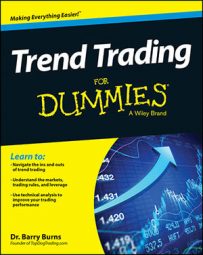Depending on the time horizon you choose for your trading style, you need to choose an appropriate time interval to use on your charts for trading. The time interval of the market primarily refers to the length of time it takes for each bar to form on a chart.
You can set up your chart so each bar lasts for one day, one week, or one month if you plan on holding a position for a long period of time.
The time interval is basically the chosen scale at which you’re viewing the market. It’s like looking at the moon through a telescope, using three different levels of magnification, depending on whether you want to see the big overall shape of the moon or zoom in on the smaller details.
If you’re a day trader, you’re more likely to choose a very short length of time for each bar, such as 2 minutes, 3 minutes, or 5 minutes.
![[Credit: Figure by Barry Burns]](https://www.dummies.com/wp-content/uploads/448314.image0.jpg)
The figure illustrates how each bar on the chart displays four points of data during its length of time:
Open: The price at which the market started during that time interval
High: The highest price the market reached during that time interval
Low: The lowest price the market reached during that time interval
Close: The last price at which the market traded during that time interval
The next figure shows an example of looking at a market on different scales, where each bar plots market movement over a very different length of time.
![[Credit: Figure by Barry Burns]](https://www.dummies.com/wp-content/uploads/448315.image1.jpg)
Figure (a) shows a daily chart, in which each bar displays one day of market activity. Figure (b), on the other hand, shows a 2-minute chart, in which each bar displays 2 minutes of market activity. Look at the bottom of the chart for the time reference (minutes, days, weeks, or months).

